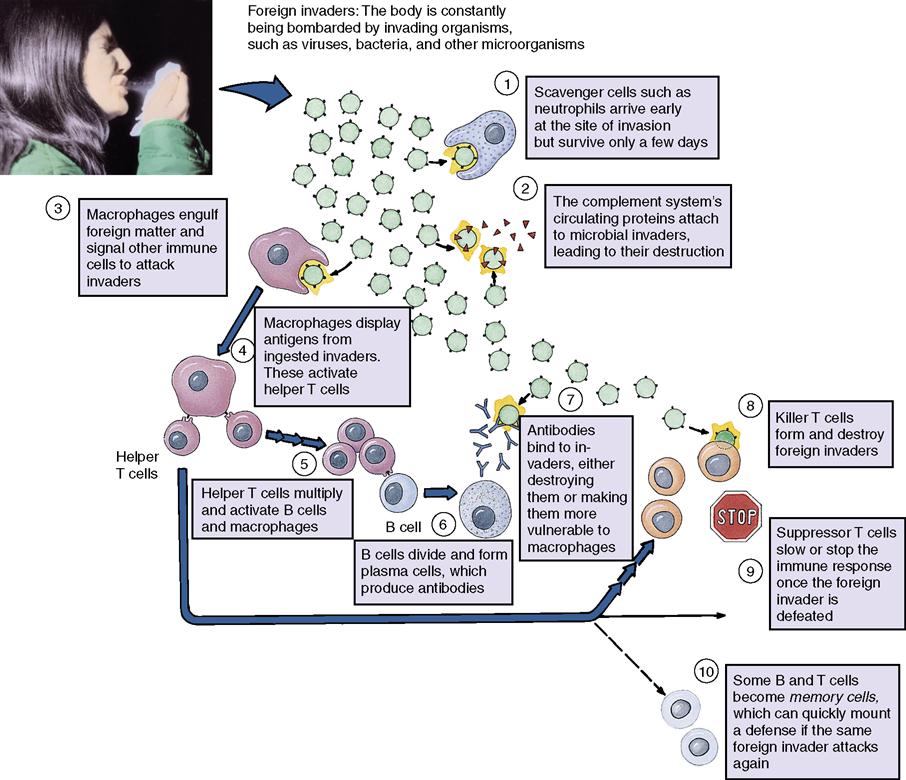The Immune and Lymphatic Systems
Objectives
1. Describe the body’s innate (natural) immune response.
2. Compare and contrast the characteristics of innate and acquired immunity.
3. Describe the role of the lymphatic system in the immune response.
4. Identify the various ways in which immunity to disease occurs.
5. Analyze the factors that interfere with normal immune response.
6. Explain the role of immunizations in relation to immunity.
1. Identify assessments that indicate immune system function.
2. Describe precautions to be taken for patients with an impaired immune system.
3. Evaluate your patient’s risk for infection during a clinical experience.
Key Terms
acquired immunity (ă-KWĪRD ĭ-MŪ-nĭ-tē, p. 202)
antibodies (ĂN-tī-bŏ-dēz, p. 197)
antigens (ĂN-tĭ-jĕnz, p. 198)
antigen-antibody response (ĂN-tĭ-jĕn ĂN-tī-bŏ-dē rē-SPŎNS, p. 201)
antitoxin (ĂN-tĭ-tŏk-sĭn, p. 200)
autoimmune disease (ăw-tō-ĭ-MŪN dĭ-ZĒZ, p. 199)
autoimmunity (ăw-tō-ĭ-MŪN-ĭ-tē, p. 202)
cell-mediated immunity (sĕl MĒ-dē-ā-tĕd ĭ-MŪ-nĭ-tē, p. 201)
complement system of proteins (PRŌ-tēnz, p. 202)
cytokines (SĪ-tō-kĭnz, p. 200)
homeostasis (hō-mē-ō-STĀ-sĭs, p. 198)
humoral immunity (HŪ-mŏr-ăl ĭ-MŪ-nĭ-tē, p. 200)
hyperpyrexia (hī-pĕr-pī-RĔX-ē-ă, p. 211)
iatrogenic (ī-ăt-rō-JĔN-ĭk, p. 203)
immune deficiency (ĭ-MŪN dĭ-FĬSH-ĭn-sē, p. 199)
immunization (ĭm-ū-nĭ-ZĀ-shŭn, p. 204)
immunoglobulins (ĭm-ū-nō-GLŎB-ū-lĭnz, p. 200)
immunoscintigraphy (ĭm-ū-nō-sĭn-TĬG-ră-fē, p. 206)
innate immunity (ĭ-NĀT ĭ-MŪ-nĭ-tē, p. 202)
lysis (LĪ-sĭs, p.200)
neutropenia (nū-trō-PĒ-nē-ă, p. 212)
passive immunity (PĂ-sĭv ĭ-MŪ-nĭ-tē, p. 202)
stromal cells (STRŌ-măl sĕlz, p. 199)
toxin (TŎK-sĕn, p. 200)
 http://evolve.elsevier.com/deWit/medsurg
http://evolve.elsevier.com/deWit/medsurg
Overview of Anatomy and Physiology of the Immune and Lymphatic Systems
What are the Organs and Structures of the Immune and Lymphatic systems?
• Bone marrow produces a type of stem cell that is able to produce all types of blood cells (white blood cells [WBCs], red blood cells [RBCs], and platelets), which then differentiate (acquire individual characteristics) into the cells of the hematologic and immune systems (Figure 10-1). B lymphocytes are produced and mature in the bone marrow and play a significant role in the humoral immune response.
• Lymph nodes and vessels circulate fluid called lymph. It contains nutrients such as proteins, glucose, monocytes, and lymphocytes. Lymph nodes (Figure 10-2) are also where most lymphocytes are initially exposed to foreign antigens such as bacteria, fungi, and viruses. 
• The lymph fluid drains into large veins, blending with the plasma circulating in the bloodstream.
• Tonsils and adenoids are lymph tissues that guard the airway from inhaled microbes.
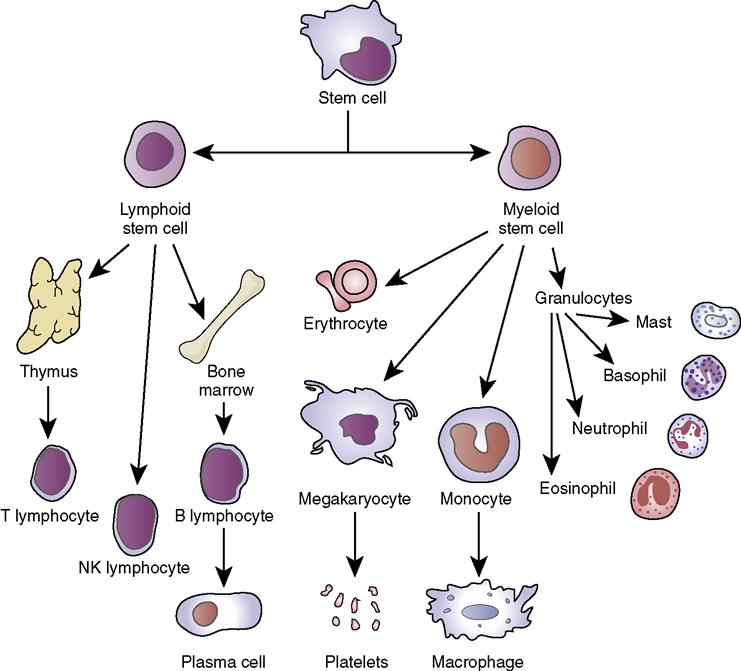
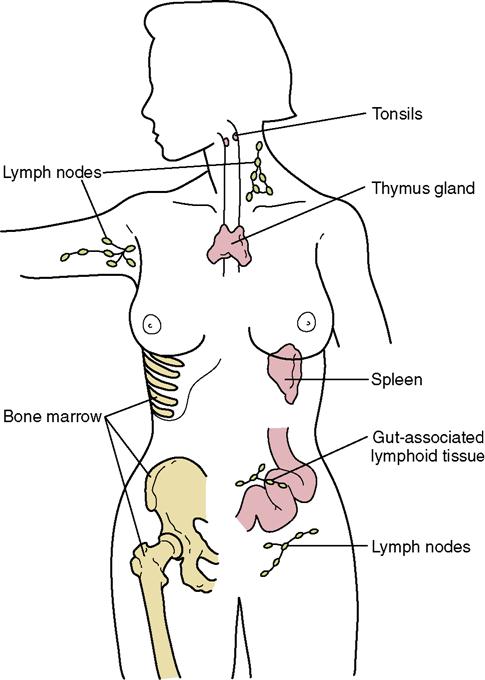
What are the Functions of the Immune and Lymphatic systems?
• Chemical mediators, plasma cells, and B and T lymphocytes play active roles in the immune response (Table 10-1).
Table 10-1
Major Components of the Immune System and Their Functions
| Component | Function |
| Antigen | Foreign substance or component of cell that stimulates immune response |
| Antibody | Specific protein produced in humoral response to bind with antigen |
| Autoantibody | Antibodies against “self” antigen; attacks body’s own tissues |
| Bone marrow | Source of stem cells, leukocytes, and maturation of B lymphocytes |
| Thymus | Gland located in the mediastinum, large in children, decreasing size in adults; site of maturation and proliferation of lymphocytes |
| Lymphatic tissue | Contains many lymphocytes; filters body fluids, removes foreign matter, immune response |
| Cells | |
| Neutrophils | White blood cells: for phagocytosis; nonspecific defense; active in inflammatory process |
| Basophils | White blood cells: bind immunoglobulin E; release histamine in anaphylaxis |
| Eosinophils | White blood cells: participate in allergic responses |
| Monocytes | White blood cells: migrate from the blood into tissues to become macrophages |
| Macrophages | Phagocytosis; process and present antigens to lymphocytes for the immune response |
| Mast cells | Release chemical mediators such as histamine in connective tissue |
| B lymphocytes | Humoral immunity–activating cell becomes an antibody-producing plasma cell or a B memory cell |
| Plasma cells | Develop from B lymphocytes and secrete specific antibodies |
| T lymphocytes | White blood cells: cell-mediated immunity |
| Cytotoxic or killer T cells | Destroy antigens, cancer cells, virus-infected cells |
| Memory T cells | Remember antigens and quickly stimulate immune response on reexposure |
| Helper T cells | Activate B and T cells; control or limit specific immune response |
| Natural killer (NK) lymphocytes | Destroy foreign cells, virus-infected cells |
| Chemical Mediators | |
| Complement | Group of inactive proteins in the circulation that when activated stimulate the release of other chemical mediators, promoting inflammation, chemotaxis, and phagocytosis |
| Histamine | Released from mast cells and basophils, particularly in allergic reactions; causes vasodilation and increased vascular permeability or edema, also contraction of bronchiolar smooth muscle, and pruritus |
| Kinins (e.g., bradykinin) | Cause vasodilation, increased permeability (edema) and pain |
| Prostaglandins | Group of lipids with varying effects; some cause inflammation, vasodilation, increased permeability, and pain |
| Leukotrienes | Group of lipids, derived from mast cells and basophils, that cause contraction of bronchiolar smooth muscle and have a role in development of inflammation |
| Cytokines (messengers) | Includes lymphokines, monokines, interferons, and interleukins; produced by macrophages and activated lymphocytes; stimulate activation and proliferation of B and T cells (communication between cells); involved in inflammation, fever, and leukocytosis |
| Chemotactic factors | Attract phagocytes to area of inflammation |
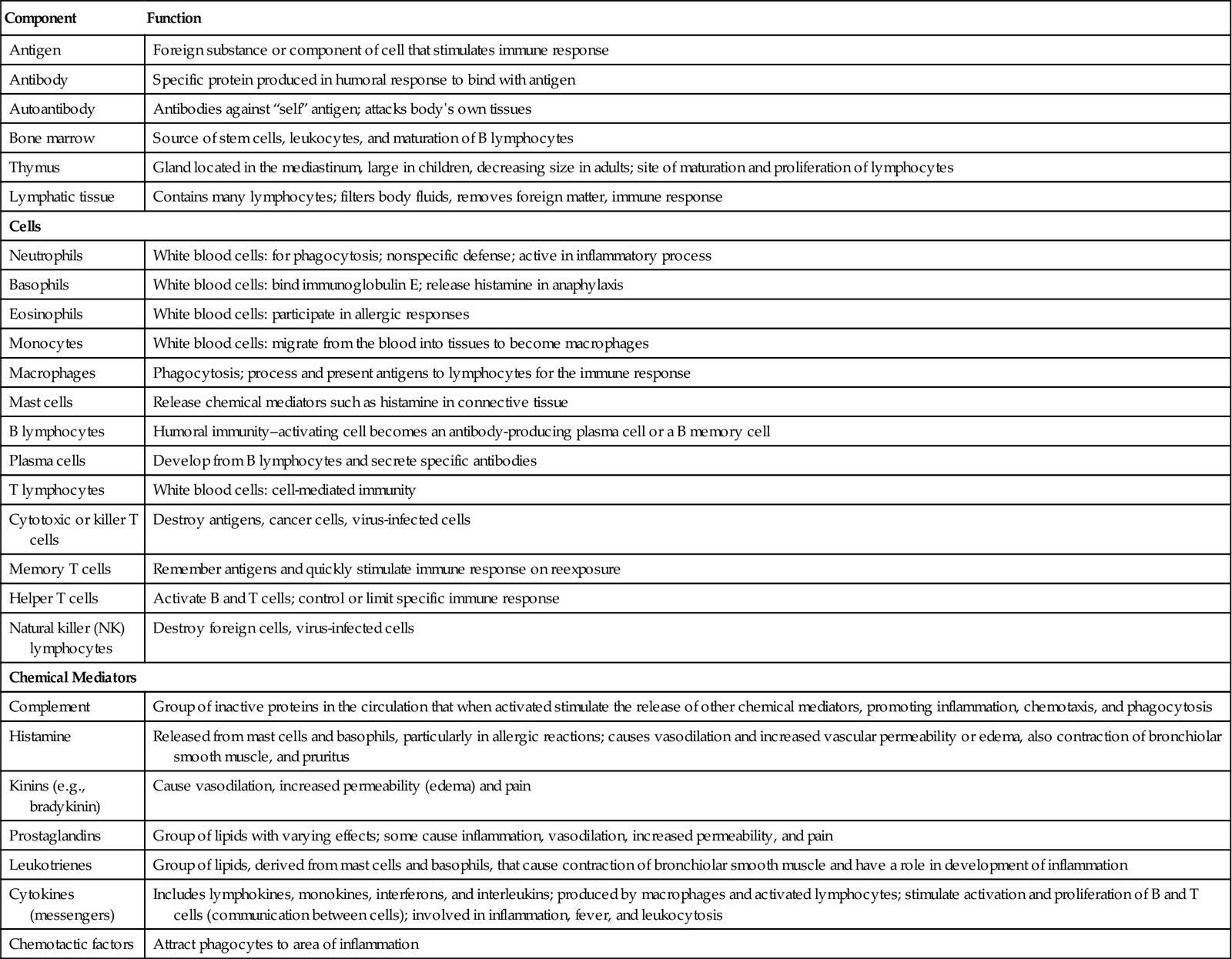
From Dyer, R., & Gould, B.E. (2010). Pathophysiology for the Health Professions (4th ed.). Philadelphia: Elsevier Saunders, p. 37.
What Effects does Aging have on the Immune and Lymphatic Systems?
Protective Mechanisms of the Immune and Lymphatic Systems
The immune and lymphatic systems work together to defend against threats from multiple sources inside and outside of the body. Except for the central nervous system, some portion of the lymphatic system is found in every part of the body. The sensory nervous system interacts with the lymphatic system by helping to alert the body to outside physical threats by relaying chemical signals back to the brain. Internally, the blood and lymphatic systems are constantly protecting against microscopic threats to homeostasis (tendency to maintain internal stability and balance). The hematologic system interacts in the production of specialized white blood cells that help fight infection and rid the body of foreign invaders. The primary job of the immune system is to protect the body from agents that can cause disease. A review of the structure and functions of the immune and lymphatic systems is necessary to understand immune responses.
The human body has multiple protective mechanisms. The first line of defense begins with the skin, tears, earwax, mucous membranes, and urinary tract. They all provide external barriers to prevent foreign substances and microorganisms from entering the body. Natural (innate) immunity is present in the body even before exposure to any unknown antigen occurs. What this means is that the body has the ability to recognize certain microorganisms as harmful, even without prior encounters. This recognition allows the body to immediately lodge a defense because the tissue damage created by the invading microorganisms releases certain chemicals within the body. These chemical triggers, such as histamine, lead to the activation of the inflammatory response, which then causes the blood and lymphatic systems to deliver certain types of WBCs, lymphocytes, proteins, and other nutrients to the affected area.
Inflammatory Response
Trauma, pathogenic microorganisms, chemicals, or heat may cause injury to tissues inside and outside of the body. The first step in the body’s defense mechanisms against this invasion is inflammation or the inflammatory response (see coverage of the inflammatory response in Chapter 6). If the injury is close to the external surface of the body, there will likely be obvious redness and swelling, and the area may also be warm and tender to the touch. These findings are due to select cells, proteins, and chemicals being sent to the affected area. The delivery of these substances increases blood flow to the site by dilating blood and lymphatic vessels upstream of the injury, resulting in warmth and redness. The same substances also affect downstream vessels, causing vasoconstriction and swelling. If the effects of swelling are not quickly controlled, the edema can compress nerve endings surrounding the area of injury, leading to a pain reaction.
The inflammatory response alone may be adequate in killing the invading organism by creating a hostile environment (see Figure 6-2). Protective proteins that are activated in the inflammatory response include the complement system of proteins. Several of these protein enzymes, when sequentially activated, form a “membrane attack complex” (MAC) that embeds itself into the cell membrane of the attacking microbe. This activation occurs when there is exposure of complement-binding sites on antibodies after they attach to antigens. This binding causes a break in the cell wall allowing for ions, such as salt, to enter the cell. The salt is followed by water, which causes swelling and bursting of the microbe.
The same WBCs, lymphocytes, proteins, and chemicals respond to internal tissue injury. The results are not as readily visible, but are detectable if appropriate assessments are conducted. The mechanisms of the inflammatory response combine with the immune response to eliminate foreign invaders (Figure 10-3).
Immune Response
The immune response is a remarkable series of complex chemical and mechanical activities that take place in the body. These activities involve (1) constant surveillance to detect the entry of foreign agents (antigens) as soon as they gain access to the body’s cells; (2) immediate recognition of the agents as “non-self” (i.e., foreign or alien); and (3) the ability to distinguish one kind of foreign agent from another and to remember that particular agent if it appears in the body again at a later time. The lymphatic system, thymus, spleen, lymph nodes, bone marrow, and Peyer’s patches in the small intestine play a major role in the immune response (see Figure 10-2). As previously mentioned, many different cells, proteins, and chemicals assist in the body’s defense against invading agents.
The immune response is usually triggered by the body’s identification of something as foreign or “non-self.” This recognition is essential for the body to respond to a foreign threat in an appropriate manner and to not react to tissues or cells that are typically recognized as “self.” When an inappropriate response happens, one of two types of disorders occurs. If there is a lack of appropriate response, an immune deficiency is present. The second type of disorder occurs when the body produces an immune response to a “self” cell or tissue, causing an autoimmune disease. It is important to recognize that while injury can activate a response by the immune system, massive trauma or chronic illness can inhibit the ability of this vitally important system to respond effectively.
Types of Immunity
Once a particular kind of foreign substance has been detected and identified, the body responds in two general ways. It immediately produces a protein (called an antibody) that is specifically designed to do battle with the antigen. The immediate response is called a humoral response.Humoral refers to any fluid or semi-fluid. There is also a delayed response that involves the use of sensitized lymphocytes to attack whole cells, such as those of bacteria, viruses, and malignant (cancer) cells. This second kind of response is called a cellular or cell-mediated response.
The cells that mediate the response are the T lymphocytes. Examples of antigens include bacteria, viruses, fungi, and other infectious microorganisms, as well as the toxins they produce as they invade the body. Nonliving matter such as pollen, dust, and chemicals can also be antigens. For some people, certain foods are perceived by the body as antigens and result in an adverse reaction, such as anaphylaxis, when the particular food is eaten.
T cells and B cells interact with each other in complex ways. Helper T cells must interact with B cells before the B cells can become plasma or memory cells. The suppressor T cells regulate the amount of antibody that B cells produce. Both T cells and B cells are necessary for a normal immune response to occur. Acquired and inherited disorders can inhibit T- and B-cell activity.
Primary Humoral Response
Lymphocytic B cells are involved in humoral immunity and the production of antibodies. They arise from stem cells in the bone marrow and undergo a maturation process that involves bone marrow stromal cells (cells that contribute to the development of multiple tissues and blood cells) and their cytokines (messenger hormones). When mature, the B cells migrate to the lymph nodes. When stimulated by an antigen, a B cell becomes a plasma cell that secretes antibody molecules into the bloodstream. B cells secrete immunoglobulins called antibodies in response to the specific antigen they encounter. This is antibody-mediated or humoral immunity (Figure 10-4). Some of the antigen-stimulated B cells become memory cells. This mechanism is the basis for acquired immunity. The memory cells reactivate the plasma cells to produce large quantities of the specific type of antibody needed to fight the particular type of antigen, when the same antigen enters the body a second time. It is an immediate and potent response, and antibodies continue to be produced for many months.

When the body is exposed to a harmful substance, the immune system produces antibodies, which are a type of protein synthesized by plasma cells. These antibodies are also called immunoglobulins. There are five classes of immunoglobulins (Ig): IgA, IgD, IgE, IgG, and IgM. Each immunoglobulin is able to attach to the kind of antigen for which it is made (Table 10-2). The antibody’s ability to form a bond with its antigen is important to the destruction of the antigen, but it can sometimes result in damage to the body’s own cells. Antibodies are found in the serum of blood and in other body fluids and tissues, including tears, saliva, breast milk, spinal fluid, interstitial fluid, lymph nodes, the spleen, and urine. An antibody can either destroy or inactivate its particular antigen by (1) mechanically harming it, (2) activating a complement system, or (3) causing the release of chemicals that affect the environment of the antigen.
Table 10-2
Immunoglobulins and Their Functions
| Class | Percent of Total* | Location | Function |
| IgG | 75–85 | Blood plasma | Major antibody in primary and secondary immune responses; activates complement system; inactivates antigen; neutralizes toxins; crosses placenta to provide immunity for newborn; responsible for Rh reactions |
| IgA | 5–15 | Tears, saliva, mucus, breast milk, GI, pulmonary, prostatic and vaginal fluids | Protects mucous membranes on body surfaces; provides immunity for newborn; prevents antigens on food from being absorbed |
| IgM | 5–10 | Attached to B cells; released into plasma during immune response | First Ig to respond to microbial invasion; activates complement systems; causes antigens to clump together; responsible for transfusion reactions in the ABO blood typing system |
| IgD | 0.2 | Attached to B cells | Receptor sites for antigens on B cells; binding with antigen results in B-cell activation |
| IgE | 0.5 | Produced by plasma cells in mucous membranes and tonsils | Binds to mast cells and basophils, causing release of histamine; responsible for allergic reactions; helps fight off parasitic invasion |

From Applegate, E. (2010). The Anatomy and Physiology Learning System (4th ed.). Philadelphia: Elsevier Saunders.
Through a process called lysis the antibody prepares the antigen for ingestion by damaging the outer membrane of the antigen’s cell. The damaged cell then ruptures, making its contents accessible for digestion by phagocytes.
If the antigen is a toxin (poison) produced by a bacterial or viral cell, the antibody produced to fight it is called an antitoxin. This antitoxin is capable of neutralizing the poisonous chemical of the antigen by covering the antigenic agent. An antitoxin is therefore a specific type of antibody that acts through the process of neutralization.
When a bacterium or other antigen enters the body, it may encounter a B lymphocyte that is specific for that bacterium or antigen. The B lymphocyte becomes a plasma cell that secretes IgM (antibody), which attacks the bacterium or antigen. After the particular bacterium or antigen is encountered for the first time, it takes 4 to 8 days for the B lymphocyte to produce immunoglobulins that can attack. If the same bacterium or antigen enters the body again several months or even years later, the immunoglobulin response by the memory cells is much quicker so that the invading cells are attacked much sooner, typically 1 to 2 days after a reexposure. The major function of the humoral antigen-antibody response is to provide protection against acute, rapidly developing bacterial and viral diseases. The antigen-antibody response is also involved in allergic and transfusion reactions.
Secondary Cellular Response
The second type of immunologic response of the body involves various interactions with antigens by T lymphocytes. Unlike the humoral response, which takes place in the plasma, the cellular response involves whole cells called sensitized lymphocytes and occurs out in the tissues. They are said to be sensitized because they have been made sensitive to a specific antigen after their first contact with it. Subsequent exposure to the antigen to which they are sensitive triggers a host of chemical and mechanical activities, all designed to either destroy or inactivate the offending antigen.
Those lymphocytes destined to provide cellular immunity pass through the thymus and migrate to the lymph tissues throughout the body. These are called the T lymphocytes (the “T” is for thymus) and they are further divided into helper T cells, memory T cells, suppressor T cells, and sensitized T cells (killer cells). T cells provide defense against viral infections. Viruses are difficult to destroy because they inject themselves into host cells and reproduce themselves. T cells respond to foreign or abnormal molecules on the surface of cells. Host cells containing virus have small fragments of the virus slightly protruding from the cell membrane. T cells identify the virus fragment as foreign and kill the host cell. T cells and macrophages produce a variety of substances called lymphokines that help destroy antigens. Killer T cells attach themselves to cells bearing antigen and secrete toxic substances that kill the antigen-bearing cells. This cell-to-cell contact response is called cell-mediated immunity or cellular immunity (Figure 10-5).
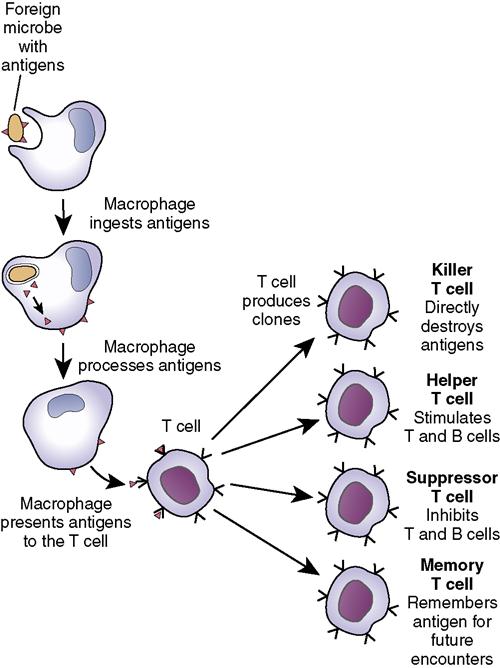
The T lymphocytes mediate (indirectly accomplish) the cellular response. When an antigen is complex (e.g., a bacterium or another type of living cell), T lymphocytes that are specifically reactive with the particular antigen mediate the cellular response in several ways. These specific T lymphocytes enter the circulating fluids of the body from the lymphoid tissues, migrate widely, and react anywhere in the body where they encounter the particular antigen. Destruction of the antigen may occur by release of chemicals into the membrane of the target cell, by secretion of lymphokines such as interleukin-2 or T-cell growth factor, or by other processes. This direct contact by the T lymphocytes with an antigen is called killer activity, and such lymphocytes are named killer T cells. Cellular immune response is often termed delayed hypersensitivity. The larger the amount of antigen present, the greater the response of sensitized T lymphocytes.
The complement system of proteins is a series of proteins produced in the liver that work with antibodies to destroy antigens. The complement system directly kills microbes by attaching to the cell wall and allowing salt and water into the cell, causing it to burst. It also assists in the inflammatory and immune response. The proteins of this system “complement” or assist the immune system.
The T lymphocytes perform immune surveillance for the body by detecting cells that enter the host and have foreign antigens on their surface. T lymphocytes are also defensive cells that patrol the blood and tissues. Sensitized T lymphocytes are the cause of allergic reactions. T cells are responsible for the inflammatory response present in people with a variety of autoimmune diseases. Autoimmunity means that there is a defective cellular immune response and antibodies are produced against normal parts of a person’s body. These T lymphocytes, along with migrating macrophages, are responsible for rejecting transplanted organs as well. This is why transplanted tissue must have surface antigens that are very similar to those of the host (transplant recipient) tissue to be accepted by the host body.
Immunity Against Disease
There are two major types of immunity to specific disease: innate (natural) immunity and acquired (adaptive) immunity. Innate immunity is present at birth. Acquired immunity occurs by actively producing antibodies when the body has been invaded by pathogens, or by receiving an immunization that causes antibodies to a specific pathogen to form.
Innate (Natural) Immunity
Unique innate, or inborn, features of human cells make a person naturally immune to certain diseases. Humans are immune to some diseases simply by being human and are not susceptible to the same diseases as animals of other species. Some immunity is related to race, gender, or a particular inherited genetic makeup. Genetic factors present at birth may predispose individuals to immune disorders (Figure 10-6).
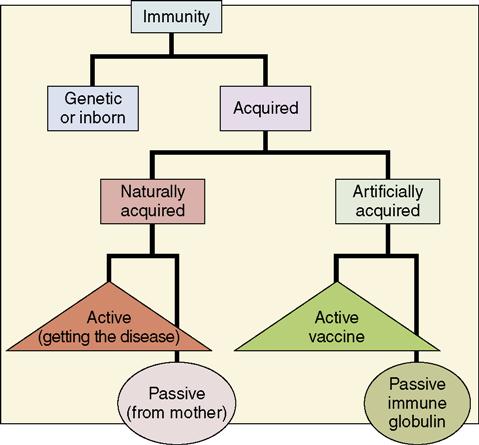
Stay updated, free articles. Join our Telegram channel

Full access? Get Clinical Tree


